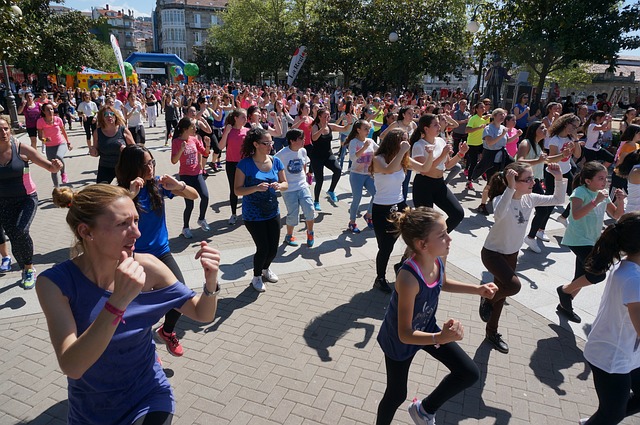Aerobics is a dynamic and invigorating form of exercise that has gained popularity for its numerous health benefits. In this article, we will learn more about the world of aerobics, understanding its definition, exploring the wide range of health advantages it offers, and examining some of the most common types of aerobic exercises.
What is Aerobics?
Aerobics is a form of exercise that combines rhythmic movements with increased heart rate and sustained endurance. It is a popular choice for individuals of all fitness levels, as it offers a range of health benefits while being adaptable to different preferences and abilities.
In aerobics, the term “aerobic” refers to the utilization of oxygen in the body to generate energy. During aerobic exercises, the muscles are continuously supplied with oxygen-rich blood to meet the increased demand for energy. This is achieved by elevating the heart rate and maintaining an increased breathing rate throughout the exercise session.
Aerobics typically involves whole-body movements that engage large muscle groups, such as the legs, arms, and core. These movements are performed in a rhythmic and continuous manner, often synchronized with music or an instructor’s cues. The goal is to sustain the exercise intensity for a prolonged period, typically ranging from 20 minutes to an hour, depending on fitness levels and individual goals.
Health Benefits of Aerobics
- Improved Cardiovascular Health: Regular participation in aerobic exercises strengthens the heart muscle, improves blood circulation, and enhances the efficiency of oxygen delivery throughout the body. This can reduce the risk of cardiovascular diseases, such as heart attacks, strokes, and high blood pressure.
- Weight Management: Aerobics is an effective way to burn calories and manage weight. Engaging in aerobic exercises regularly can help burn excess body fat, improve metabolic rate, and contribute to maintaining a healthy body weight.
- Enhanced Respiratory Function: Aerobic activities require increased oxygen intake, promoting improved lung capacity and respiratory function. This can benefit individuals with respiratory conditions, such as asthma, by strengthening their respiratory muscles and increasing their tolerance to physical exertion.
- Mental Well-being: Aerobics is known to release endorphins, which are natural mood-boosting chemicals in the brain. Regular participation in aerobic exercises can help reduce stress, anxiety, and symptoms of depression. It can also improve cognitive function and enhance overall mental well-being.
Common Types of Aerobic Exercises
- Brisk Walking: Walking at a fast pace is one of the simplest and most accessible forms of aerobic exercise. It can be done anywhere, requires minimal equipment, and is gentle on the joints. Aim for at least 30 minutes of brisk walking most days of the week.
- Jogging or Running: Running or jogging elevates the heart rate significantly and provides a higher intensity aerobic workout. It strengthens muscles, improves cardiovascular fitness, and burns calories. Start slowly and gradually increase speed and distance to avoid injury.
- Cycling: Whether outdoor cycling or stationary biking, this low-impact exercise offers a great aerobic workout. Cycling strengthens the leg muscles, improves endurance, and can be adapted to various fitness levels.
- Dance Fitness: Zumba, aerobics dance classes, or dance-based video games provide a fun and energetic way to get your heart rate up. These exercises combine dance moves with aerobic elements, promoting cardiovascular fitness and coordination.
Aerobics offers a wide variety of options to suit individual preferences and fitness levels. From brisk walking and jogging to cycling, dance fitness classes, or aerobic workouts at home, there are numerous ways to incorporate aerobic exercises into a fitness routine. The key is to find activities that are enjoyable, sustainable, and aligned with personal goals.
Aerobics is a versatile and beneficial form of exercise that promotes healthy body and mind. By incorporating aerobic exercises into your fitness routine, you can experience an array of health benefits while enjoying the energetic and invigorating nature of these activities. Find an aerobic exercise that suits your preferences and fitness level, and embark on a journey towards improved health and vitality.
Image by Luís Baños from Pixabay
Fitness
-

How to Hydrate Properly for Muscle Health
Proper hydration is crucial for overall health and plays a vital role in supporting muscle function and development. Muscles are composed of a significant amount of water, and maintaining adequate hydration levels is essential for optimizing muscle performance, preventing muscle cramps, and supporting muscle recovery. In this article, we explore the link between hydration and…
-

Try Aerobics for Overall Health, Fitness, and Fun
-

Mindful Running: How to Incorporate Mindfulness and Mental Focus into Your Running Routine
-

Proper Running Form and Techniques – How to Boost Your Performance and Prevent Injuries
-

How to Start Running Today for Health and Fitness
-

Unleashing Your Strength: Exploring Resistance Training and Its Various Types
-

How to Build Muscle Mass – From Strength Training to Protein-Rich Foods








Leave a Reply